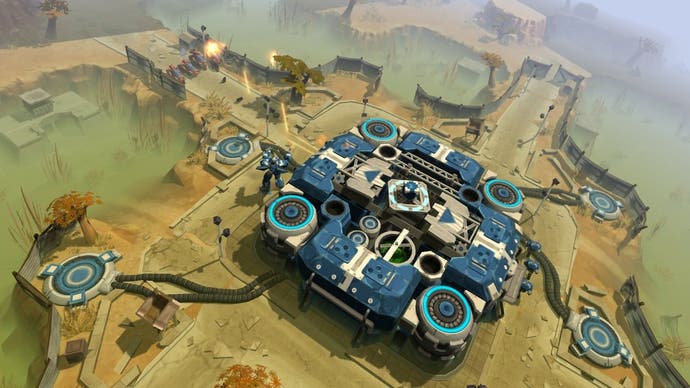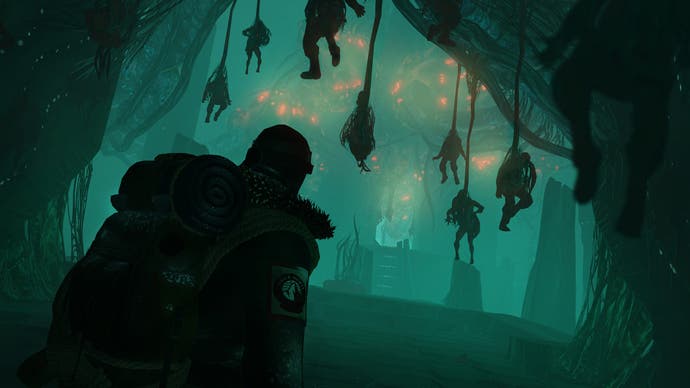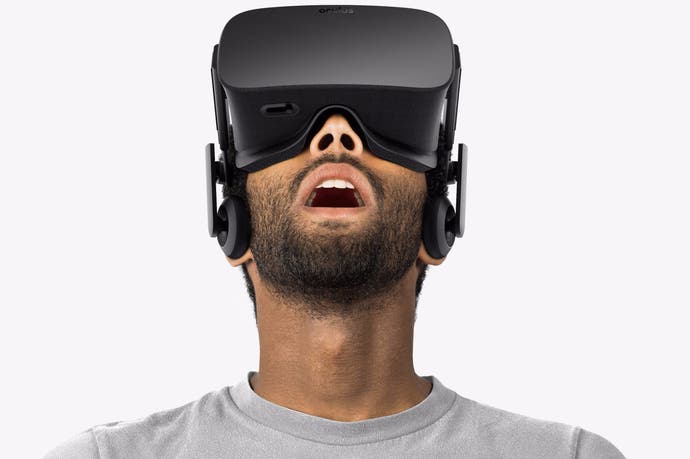Rift's launch line-up has the quality and quantity - but is it too safe?
The VR twist, rather than the VR difference.
Oculus showed 41 games for the Rift VR headset in San Francisco ahead of this week's Game Developers Conference. Impressively, a full 30 of them will launch with Rift in a couple of weeks on 28th March. Most of the remaining 11 will follow hot on their heels. This is great software support by the standards of any game hardware launch I can think of, let alone one by a company new to this sort of thing (albeit with Facebook's deep coffers behind it). Oculus' confidence in putting it all on display is justifiable.
More so when you consider just how polished the games on display were. The VR scene has been dominated up to this point by proof-of-concept demos, indie experiments and hacked support for popular titles. Oculus has games, real games, substantial games, all of them running smoothly and ready to go. There's a broad mix too, of strategy, sport, puzzle and action games, of names like Project Cars and The Vanishing of Ethan Carter alongside indie recruits to the cause and the fruits of Oculus' nascent publishing program - games like the mascot platformer Lucky's Tale and Insomniac's slick action-adventure Edge of Nowhere.

Software sells hardware, and in this department Oculus seems to be getting a lot of things right, which will come as a relief after the bruising blow dealt yesterday by Sony, which has priced PlayStation VR $200 cheaper than Rift (never mind the difference in cost between a PS4 and a VR-ready PC). In the battle of the hardware platforms, Oculus, despite having been the one to prove VR was ready for its close-up in the first instance, now risks getting caught in the middle between the cheaper and more mass-market PlayStation VR and the money-no-object HTC Vive with its astonishing 'room scale' capability. But Rift has the games to back it up, right here, right now. As so many hardware platforms have proven in the past, it only takes one game to make all the difference in the world. One of these 41 could be the one to do it.
But I'm not sure any of them will, because Oculus, in its understandable desire to present a catalogue of games it knows will work and that people will want to play, hasn't found the brand new , native VR experience that will really sell the virtual reality dream. Make no mistake these games are transformed by VR and made so much more exciting by it - it really is one hell of a party trick. But all of them that I tried would have been quite playable without it.
Indeed, some of them will be. Adrift, the beautiful and terrifying space survival game, is not a Rift exclusive, although if you want to experience the stomach-churning horror of being cut loose in zero G to its fullest, you need to try it in VR. Rated as 'intense' in Oculus' new comfort rating system, with good reason, this disorienting first-person adventure was too much for me - likely because it came at the end of a few solid hours of VR demos. And to be fair, if any videogame should make you feel sick, it's one about emerging from an airlock to see the earth turning thousands of miles beneath you - a truly breathtaking moment in VR. Rift adds immense presence and spectacle, but fundamentally it doesn't do anything the 2D game won't.

Interestingly, Oculus also had a lot of third-person games on display, and these are a lot easier to enjoy. Several of the games I played had lofty, strategy-game-style cameras, and even when these cameras move and when the games are played sitting down, they present little risk of nausea. They also bring with them the intense, toylike joy of seeing little action figures come to life in the maps before and below you. AirMech Command is a fun, simplified real-time strategy game with some MOBA influences that plays well with a pad, and its chunky little units translate with wonderful tactility into VR. They just look real. Manipulating its camera skips and zooms takes a little getting used to, but it's probably worth it for VR's unique eagle-eye view of the battlefield.
Smashing the Battle is a Japanese-developed manga brawler in which ladies in power suits battle robots in simple arenas, with crisp and enjoyable battle mechanics that soon absorb you to the extent that you forget you're viewing it in VR. Is that a good thing? I'm not sure. Another Japanese game, Fly to KUMA, is a Lemmings-style puzzler by Colopl that involves building a safe route for a troupe of bears to reach an escape pod. With its sterile presentation, I had no idea why I was playing it in VR at all. Similar was true of the same developer's VR Tennis Online, a perfectly serviceable Vritua Tennis-alike where the main (and admittedly enjoyable) twist of playing it in virtual reality is that you have to look up to watch the ball toss and judge the timing of your serve.
These were almost all fun games, and witnessing them in VR was inherently fun too. But you had to look to Edge of Nowhere to see where Oculus' conservative approach to software could actually hit its mark. It's another very familiar genre piece - in this case, an Uncharted or Tomb Raider-style action game with streamlined inputs, a linear thrust, and a lot of clambering around with ice picks. Its Lovecraftian influence and the clean, frosty cartoon of its snowbound look distinguish it to some extent. But Insomniac has put tremendous thought and craft into how this kind of third-person experience might work in virtual reality, and the result is something that is instantly familiar and thrillingly novel.

Nausea isn't a problem, because movement is fairly slow and you can only turn the camera (and indeed, aim weapons) with your head movement. What's most exciting is how real and solid the environments feel; in Adrift, you're still conscious of looking forward through the portal of your character's eyes, as you are in any first-person game, but in Edge of Nowhere, you sense the space around you: the vertiginous drops you'll see if you look down between your feet, the glittering walls of ice to either side, the impenetrable darkness of the cavern ahead.
It's a terrific experience, and one that could convert a lot of people to VR, especially those who like their games the way they like them - experiences to sit down and have wash over you. But it is still just a better way of playing something you already have. Some Vive demos - or even the asymmetrical multiplayer hijinks of Sony's hilarious The Playroom VR - have already shown that this technology can give us entirely new experiences, too. If it doesn't want to end up playing the man in the middle, Oculus should be looking to show us some of those as well.









